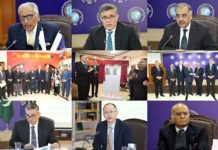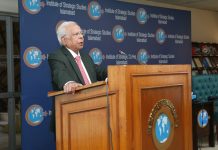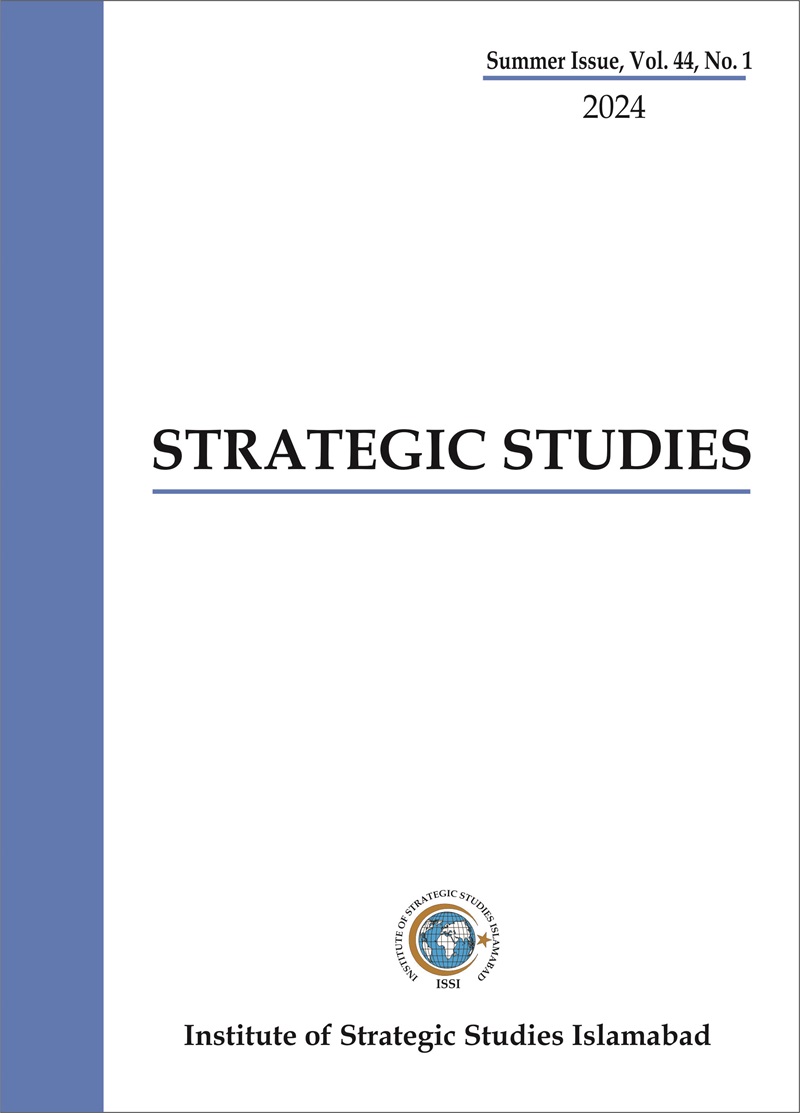Balancing South Asian Nuclear Security Triangle
Dr Adil Sultan *
At the outset let me contest the concept of South Asian nuclear triangle, which seems to imply that there exists triangular nuclear security interdependence between China, Pakistan and India. Instead, South Asian nuclear equation is dyadic, at least for the foreseeable future. India, however would like to be equated with China and rest of the world is willing to accept this narrative for their respective strategic, political and economic interests.
In one of the earlier seminars held here at ISSI earlier (Oct 2015), I had underscored this point that India’s desire to compete with China is essentially aimed at enhancing its status and to be reckoned as a great power, but this relatively new struggle is “without the force of history behind it”.
One cannot completely rule out India’s rise as a regional or a global power, with the assistance of external powers, but this may take time, and also favorable strategic environment and further convergence of interests, which itself cannot be guaranteed in this fast changing unpredictable international environment.
Since the seminar is about NP and strategic export control system, therefore, I would like to focus on the ongoing trends of discrimination and exceptionalism, which not only undermine existing global norms, but is also adversely affecting South Asian regional security environment.
Once we talk of balancing the nuclear security equation, it is important to understand why this balance was disturbed at the first place.
Pakistan was a reluctant entrant in the nuclear field, as it was considered an unfeasible option for a country with limited technological and financial resources. In order to keep the region free of nuclear weapons, Pakistan offered several proposals before the overt nuclearization of the region. After the 1998 tests, Pakistan continued to offer bilateral arrangements to ensure strategic stability in South Asia.
India, nevertheless, is increasingly becoming dismissive to engage with Pakistan, due to its growing strategic partnership with the US and other major powers. Instead of encouraging India to follow international norms, the US has embarked on creating new norms of exceptionalism, with a stated objective of helping India to become a ‘Super Power’. Interestingly, this would be the first and probably the last time, where one super power would be helping another country to emerge as a rival super power – against the fundamental principles of ‘realpolitik’.
In 2008, the US entered into nuclear cooperation agreement with a non-NPT state India. This deal could not have materialized without the exemption from the guidelines of 48 members Nuclear Suppliers Group (NSG), which controls civil nuclear trade and works on the basis of consensus. This exception that was a result of arm twisting of several leading opponents, facilitated India to enter into nuclear cooperation agreement with over dozen countries.
India can now acquire fuel and uranium for its civilian reactors, while diverting the indigenous uranium reserves purely for military purposes. This according to senior former US officials would have significantly increased India’s bomb making potential.
As part of the requirement for the NSG exemption, India agreed to a civil-military nuclear separation plan. According to one of the recent reports by the Belfer Center, co-authored by former head of Australia’s safeguards, India’s separation plan is a unique in a way that has three different streams; ‘civilian safeguarded’, civilian unsafeguarded’ and military reactors.
The arrangement allows India to use foreign supplied fuel in its ‘civilian unsafeguarded’ facilities by putting these facilities under ‘temporary safeguards’. This is in contrast to the understanding given by US Administration to its Congress in 2008 that the safeguards would be applied in perpetuity. This is important, especially keeping into consideration the fact that several of India’s PHWRs have reportedly been used as sources of weapons grade Pu for its military program, as India could use its civilian unsafeguarded PHWRs to produce more nuclear weapons. This isa cause of serious concern for Pakistan.
Another unique feature of India’s safeguards arrangement is that it can substitute ‘unsafeguarded’ nuclear material for ‘safeguarded’ material with the IAEA’s consent, and “remove weapons-grade plutonium from safeguards and use it in nuclear weapons, provided it places an equal amount of reactor-grade plutonium under safeguards”.
India has also declared that its Fast Breeder Reactors (FBRs) would remain outside the IAEA safeguards. These reactors, the prototype of which is expected to be online in the next few months, are capable ofproducing large quantities of Pu, which would significantly enhance India’s fissile material capacity. India’s upcoming Special Material Enrichment Facility (SMEF) has also been kept outside the safeguards, which would have the potential to produce large quantities of enriched uranium for thermonuclear weapons.
India has a track record of misusing Canadian supplied Cirus reactor for producing Pu for its 1974 nuclear weapon test, “despite being under an obligation not to use the reactor or any products resulting from its use for military purposes.” This episode became the basis for the creation of the NSG in 1975. Ironically, the same NSG is now contemplating granting India its membership.
The NSG members must take into consideration the serious implications of granting another discriminatory favor to India by allowing it to become a formal member of the Group without asking India to rectify the existing anomalies. Several NSG states that have entered into nuclear cooperation agreement with India, mainly for commercial gains, could possibly be guilty of assisting India’s nuclear weapons program, without verifiable mechanism of tracking their supplied material. These countries could be held accountable for violating their obligations under Article 1 of the Nuclear nonproliferation Treaty (NPT), which makes it obligatory for the member states not to assist directly or indirectly nuclear weapons program of any other country.
In order to pave the way for India’s NSG membership, last week at Vienna, India requested NSG’s Consultative Group meeting for an interactive session, to remove any possible hurdles before it submits its formal application for the NSG membership before or during the forthcoming NSG Plenary meeting to be held at Seoul, South Korea in June 2016. India wants to push its case for the membership before the end of President Obama’s tenure, knowingly well that it may have to rebuild the support for its candidacy with the next US Administration, which may not be guaranteed.
The NSG, as a nonproliferation instrument, had the opportunity to universalize the global NP norms by integrating the original three non-NPT states in the mainstream regime. By creating another exemption, the NSG would not only lose its credibility, butit may provide incentive for some of the NPT states to give up their obligations in the future and pursue the weapons path.
Eagerness by few major powers to accommodate India within the Group for their short sighted strategic and commercial interests would only weaken the established norms. The responsibility for the eventual demise of the regime, as a result of such exceptions, rests with the NSG and the major powers that are supporting India exclusive membership.
Such discriminatory trends do not bode well for strategic stability in South Asia, as it reduces the incentive for countries like Pakistan that is directly affected by India’s massive nuclear build up, to remain meaningfully engaged with the international nonproliferation regime.
Pakistan is ready to play more active role in strengthening global nonproliferation norms, provided these are based on the principles of ‘inclusiveness’ and ‘non-discrimination’.
*. Dr Adil Sultan works on arms control issues and is a Visiting Faculty at the National Defense University, Islamabad.













